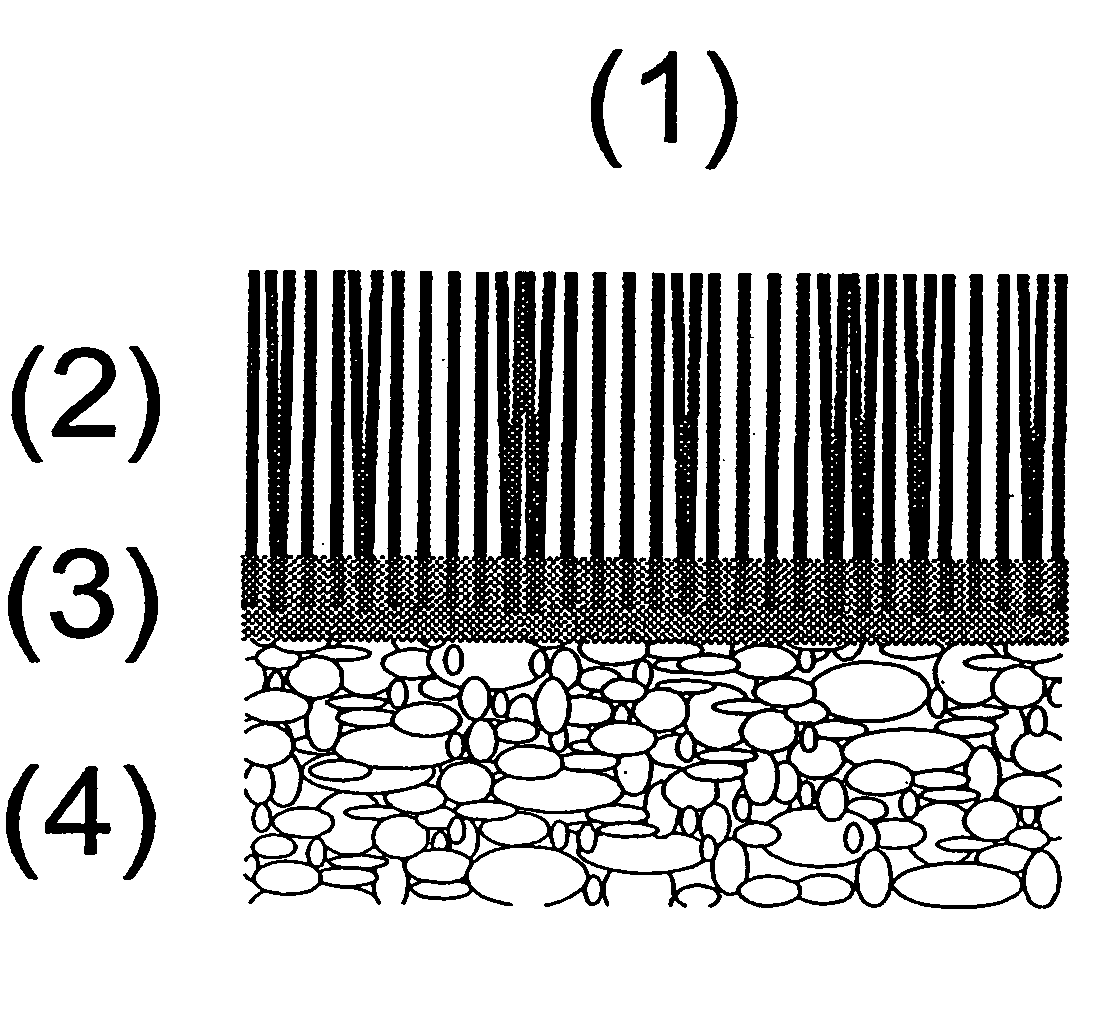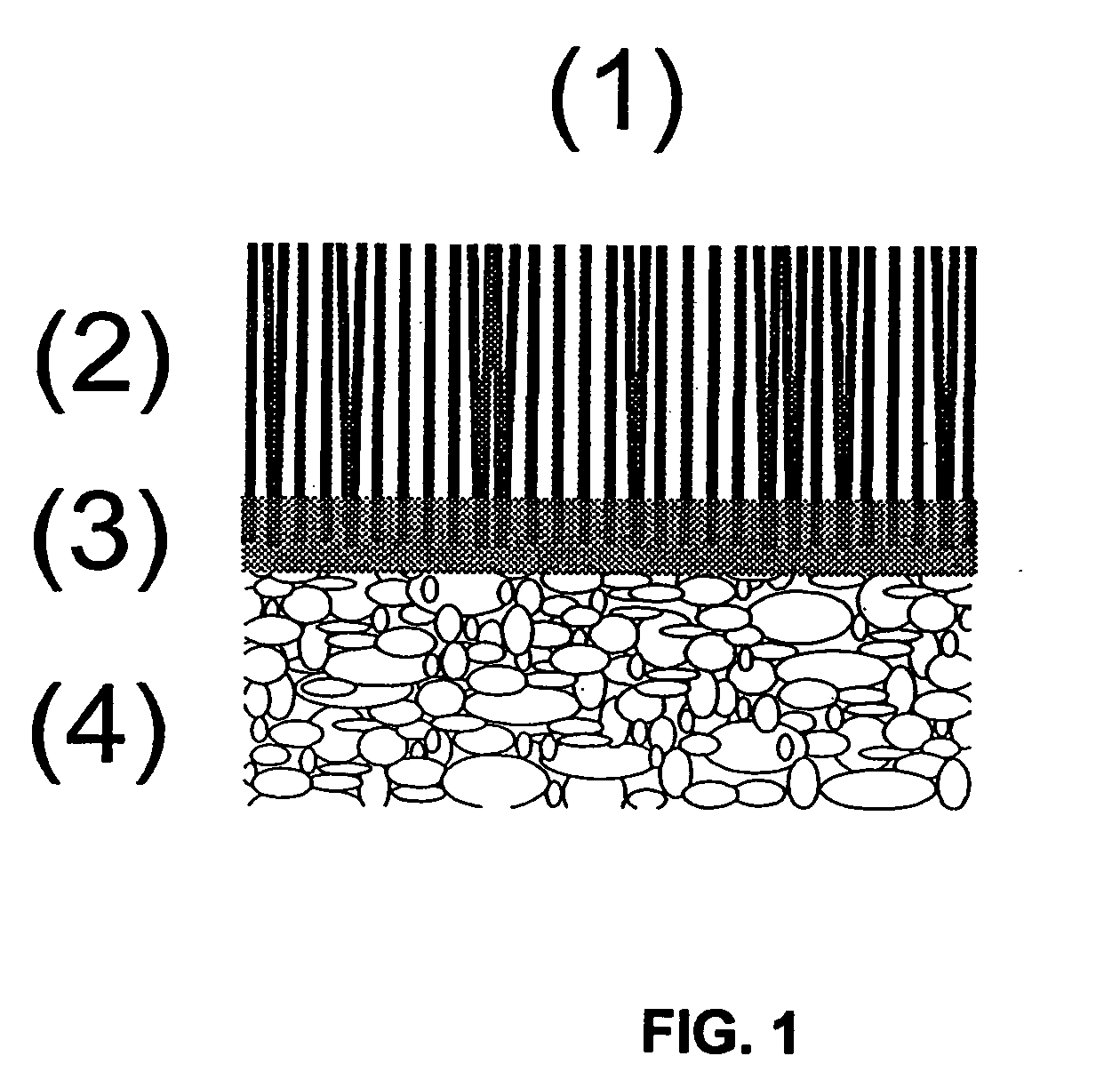Prosthetic Devie for Cartilage Repair
a cartilage repair and prosthetic technology, applied in the field of prosthetic devices, can solve the problems of stress and friction, joint failure to permit motion, and limited regeneration capacity of articular cartilage, and achieve the effects of rapid cartilage growth, excellent mechanical stability, and improved stability of a prosthetic articular cartilage devi
- Summary
- Abstract
- Description
- Claims
- Application Information
AI Technical Summary
Benefits of technology
Problems solved by technology
Method used
Image
Examples
example 1
[0055] A prosthetic device is engineered from a porous interconnected cylindrical beta-tri-calcium-phosphate body sizing 5 mm in diameter and 10 mm in height, as subchondral anchor, and a 4 mm layer of oriented poly-hydroxy-ethyl-methacrylate (pHEMA) fibers with a diameter of 25 micrometer, as oriented fiber layer grafted to the anchor by a cement reaction. The vertical arrangement of the pHEMA fibers is random, but closely packed. The resulting prosthetic device is an ideal implant for cartilage repair.
[0056] A properly sized tubular chisel is introduced perpendicular to the defect site in the joint. In a first step in the implantation, the chisel is tapped into cartilage and the osseous base of the defect site. The defect size is exacted regarding depth and diameter to the specific dimensions of the prosthetic device. Subsequently, the anchor of the graft is soaked in a saline solution before the prosthetic device is inserted through the universal guide tool. No additional fixati...
example 2
[0057] A prosthetic device is engineered from a porous interconnected cylindrical hydroxyapatite body sizing 8 mm in diameter and 15 mm in height, as subchondral anchor, and a 4 mm layer of oriented and chemically derivatized methylcellulose fibers with diameters ranging between 1 and 50 micrometers, as oriented fiber layer. The fiber layer is obtained by embroidery and chemically grafted to the anchor by embedding. The vertical arrangement of the methylcelluose is a well-defined 2-D pattern. The resulting prosthetic device is an ideal implant for cartilage repair.
[0058] A properly sized tubular chisel is introduced perpendicular to the defect site in the joint. In a first step in the implantation, the chisel is tapped into cartilage and the osseous base of the defect site. The defect size is exacted regarding depth and diameter to the specific dimensions of the prosthetic device. Subsequently, harvested bone marrow stromal cells are added to the ceramic anchor. Next, the prostheti...
example 3
[0059] A prosthetic device is engineered from a porous interconnected cylindrical beta-tri-calcium-phosphate and calcium sulfate composite body sizing 12 mm in diameter and 10 mm in height, as subchondral anchor, and a 5 mm mixed layer of highly oriented polypropylene and polyetheretherketone fibers with a diameters ranging 0.5 to 30 micrometer, as oriented fiber layer. The vertical arrangement of the fibers is random, but closely packed. The resulting prosthetic device is an ideal implant for cartilage repair.
[0060] A properly sized tubular chisel is introduced perpendicular to the defect site in the joint. In a first step in the implantation, the chisel is tapped into cartilage and the osseous base of the defect site. The defect size is exacted regarding depth and diameter to the specific dimensions of the prosthetic device. Bone marrow stromal cells and platelet rich plasma is added to the anchor, and the prosthetic device is inserted subsequently by the universal guide tool. No...
PUM
| Property | Measurement | Unit |
|---|---|---|
| diameter | aaaaa | aaaaa |
| height | aaaaa | aaaaa |
| height | aaaaa | aaaaa |
Abstract
Description
Claims
Application Information
 Login to View More
Login to View More - R&D
- Intellectual Property
- Life Sciences
- Materials
- Tech Scout
- Unparalleled Data Quality
- Higher Quality Content
- 60% Fewer Hallucinations
Browse by: Latest US Patents, China's latest patents, Technical Efficacy Thesaurus, Application Domain, Technology Topic, Popular Technical Reports.
© 2025 PatSnap. All rights reserved.Legal|Privacy policy|Modern Slavery Act Transparency Statement|Sitemap|About US| Contact US: help@patsnap.com


